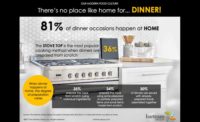Consumer Eating Occasions
IFMA and Datassential unveil a new view of foodservice consumer eating behaviors.

SOURCE: CORNER BAKERY CAFÉ




Simon Marshall, president, Unilever Food Solutions, and chairman of IFMA’s Consumer Planning Program committee





For decades, foodservice organizations have examined consumer behavior through day parts, operator segments, and other industry-defined attributes. These long-used metrics speak primarily to the resulting consumer activity: “Where did he go for lunch?” “What did she order for her QSR dinner?”
Although this approach has proven useful in tracking what consumers do, it doesn’t reveal much about why they make those decisions. This, of course, poses a real challenge for marketers; it’s hard to change consumer behavior if you don’t know why they’re behaving that way in the first place.
And this is the challenge that IFMA and Datassential set out to solve two years ago. Can we create an effective industry model for understanding the “why” behind the “what?” We’re happy to report that with the help of 20 leading food manufacturers and more than 25,000 consumers surveyed, the industry now has a model.
28 Occasions
Think back to the very last restaurant you visited. How would you characterize the scenario that led you to that choice? Were you looking for a cheap bite, or were you perhaps trying to impress someone? Was it while you were out running errands, during your morning commute, or maybe just a quick bite on your way home?
More than likely, your last restaurant experience will fall into one or more of the following 28 occasions.
It’s interesting to take a closer look at what occasions are or are not—in conjunction with scenarios and motivations.
Occasions are scenarios—the situations faced by the consumer. Then, we also consider motivations, which are the underlying impulses for that away-from-home activity. Meanwhile, it’s important to remember that occasions are not mutually exclusive. A single trip could be both a “quick bite” and a “cheap bite.” We also see occasions impact the resulting “need states” but are not need states in and of themselves.
More meaningful discrimination
Occasions get at the core of consumer motivation and as a result, they represent a far better predictor of behavior than are demography, day parts, and other traditional metrics.
Consider the case of Italian restaurants. Traditional demographic analyses don’t really reveal anything that’s particularly interesting or actionable. Italian restaurants account for 3% of male traffic, as well as 3% of female traffic. Millennials (3% Italian visitation) and Boomers (4%) are generally similar too, as are white (4%) and African American (3%) consumers. Regardless of demography, Italian restaurant visitation tends to center around 3%.
The occasion “lens,” on the other hand, offers a much clearer picture. Consumers visit Italian restaurants far more often for certain occasions than they do others. For instance, Italian restaurants account for 11% of “formal dinner” occasions, but are visited just 1% of the time when consumers want a “quick bite.” This new perspective helps us better identify nuances in visitor traffic, while also offering a fundamental understanding of why consumers make that choice.
So what do you do if you’re an Italian restaurant? The occasion model provides an answer. Italian restaurants align most strongly with low-frequency occasions, but aren’t drawing traffic for common occasions such as “quick bite,” “casual dinner,” or “family meal.”
And it’s here where we uncover a key strategic “a-ha!” As a group, Italian restaurants would be well served to target these more common occasions—perhaps through more casual offerings and quicker dining options.
Occasions differ
Occasions determine what consumers want and need when they have food and beverages away from home. For instance, consumers favor classic American foods for the “last minute dinner” occasion; authentic ethnic dishes, however, are comparatively more appealing when having a “special occasion.”
Some occasions also are more “spendy” than others. Whereas consumers spend an average of $17.54 for a “romantic meal,” an occasion such as “hanging out with friends” generates just $10.95.
|
Manufacturer’s Perspective: Unilever Food Solutions
Prepared Foods talks with Simon Marshall, president, Unilever Food Solutions, and chairman of IFMA’s Consumer Planning Program committee. Unilever, Lisle, Ill., processes and distributes foodservice dressings, sauces, seasonings, sauces, soups, desserts and drinks under the Knorr, Hellman’s and Lipton brands.
Prepared Foods: How long have you been involved in IFMA’s CPP initiative?
Simon Marshall: I was vice chair for the group through 2013 and took responsibility for the group at the beginning of 2014.
PF: In what ways has CPP already helped Unilever improve its relationships with customer operators?
Marshall: Growth in foodservice remains challenging, not the least because consumer habits and demands are changing. We have to stay at the forefront of those changes to ensure we can continue to earn more of the consumers’ food dollar spend. This is an industry challenge and operators are looking to suppliers for consumer insights and understanding to help ensure they meet these changing consumer expectations.
Our work with IFMA’s CPP has been a tremendous source of such insight. We are finding that operators are increasingly keen to understand more about consumers and their changing expectations.
PF: Prepared Foods serves executives in R&D, culinary, nutrition and marketing. Any thoughts about how CPP influences and/or improves your product development process?
Marshall: It’s for each supplier-operator to determine which insights are the most important, but clearly any new product development has a much greater chance of success if it is aligned to consumer needs—as well as a solution for the operator.
Consumers are changing their [product and menu] expectations with increasing speed – well within the time frame of new product development. That’s why it’s increasingly important to understand what those new expectations are—before they fully materialize.
|
There’s a lesson in this for the operator: Your menu and how it’s priced should reflect the types of occasions you want to target. Understanding what consumers want and how much they’re willing to spend for each occasion should be a driving force of smart menu development.
Fingerprinting the occasion
Each restaurant, cafeteria, and other foodservice location has a distinct “fingerprint,” a unique combination of patron profile, visitation drivers, attribute performance, and, of course, occasions.
Whereas restaurant chains have often historically set broad general goals such as to “improve lunch traffic” or “build dinner time appeal,” occasions allow us to take a meaningful and more focused next step, one that better mimics the consumer decision process.
Datassential’s BrandFingerprints program provides chain-specific details.
Let’s take a look at Subway and Panera. Although both are limited-service venues that offer sandwiches and salads, their respective occasion sets are quite different. Subway is far more likely to be visited for “dinner on the way home,” whereas consumers are more likely to choose Panera when “hanging with friends.”
Now if you’re Panera, why not set your sights on “dinner on the way home?” It’s an occasion that accounts for 8% of all away-from-home visits and roughly $27 billion in annual consumer spend—a big opportunity that could be worth exploring further.
For restaurant chains—and the suppliers that support them—using the occasion model is as simple as 1-2-3.
Step 1: Prioritize target occasions
Identify the whitespace. For which occasions do key gaps exist in either current traffic patterns or consumer appeal?
Step 2: Determine need states
Each occasion carries its own set of key need states; use occasions to filter the ones that matter most for your priorities.
Step 3: Develop solutions
Now that you’ve identified the critical need states for your priority occasions, you can test how well new menu and marketing ideas solve those needs.
For information on how an organization can benefit from the Occasion Model, contact either Datassential (www.datassential.com) or IFMA (www.ifmaworld.com)
Looking for a reprint of this article?
From high-res PDFs to custom plaques, order your copy today!










